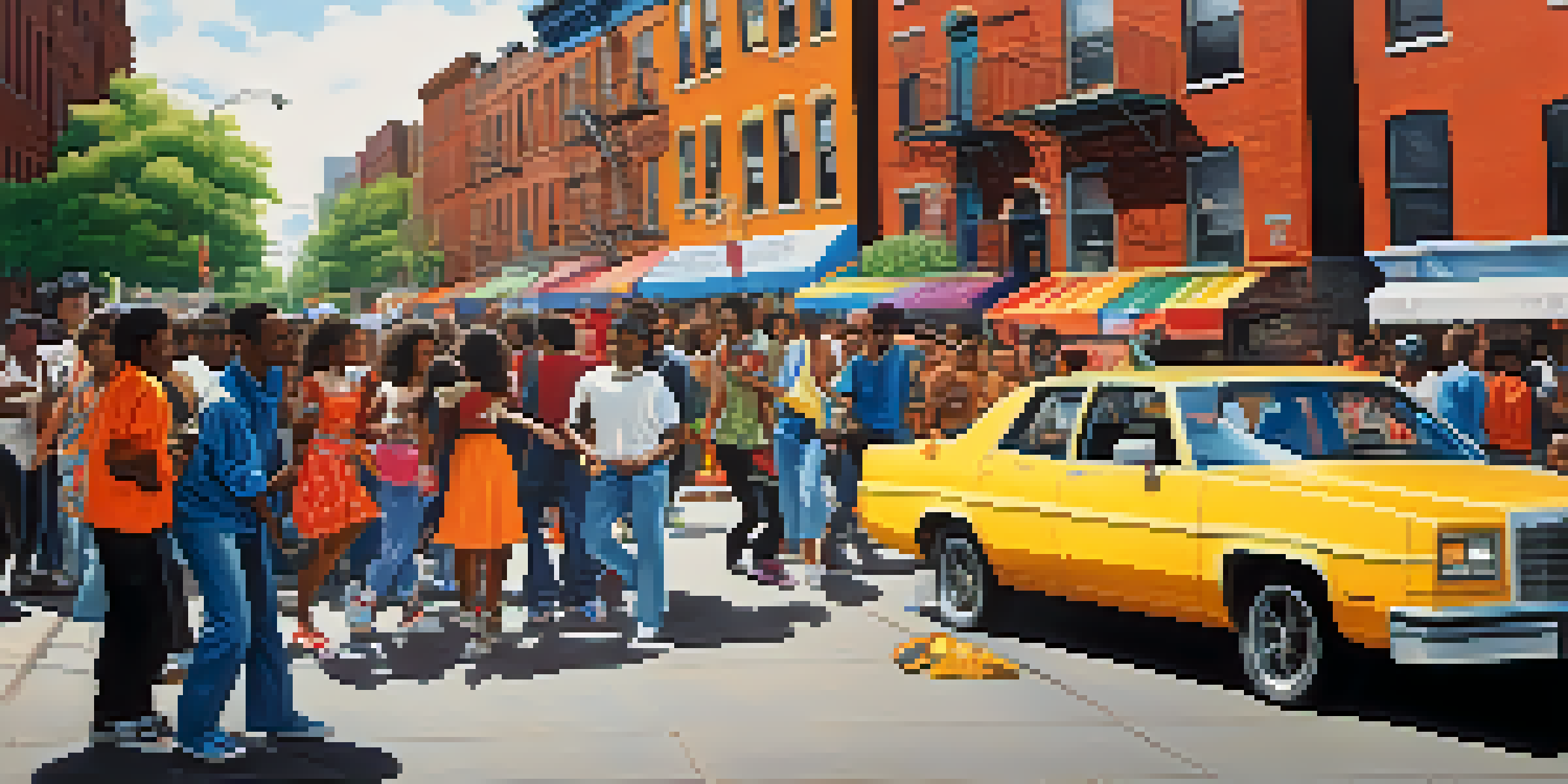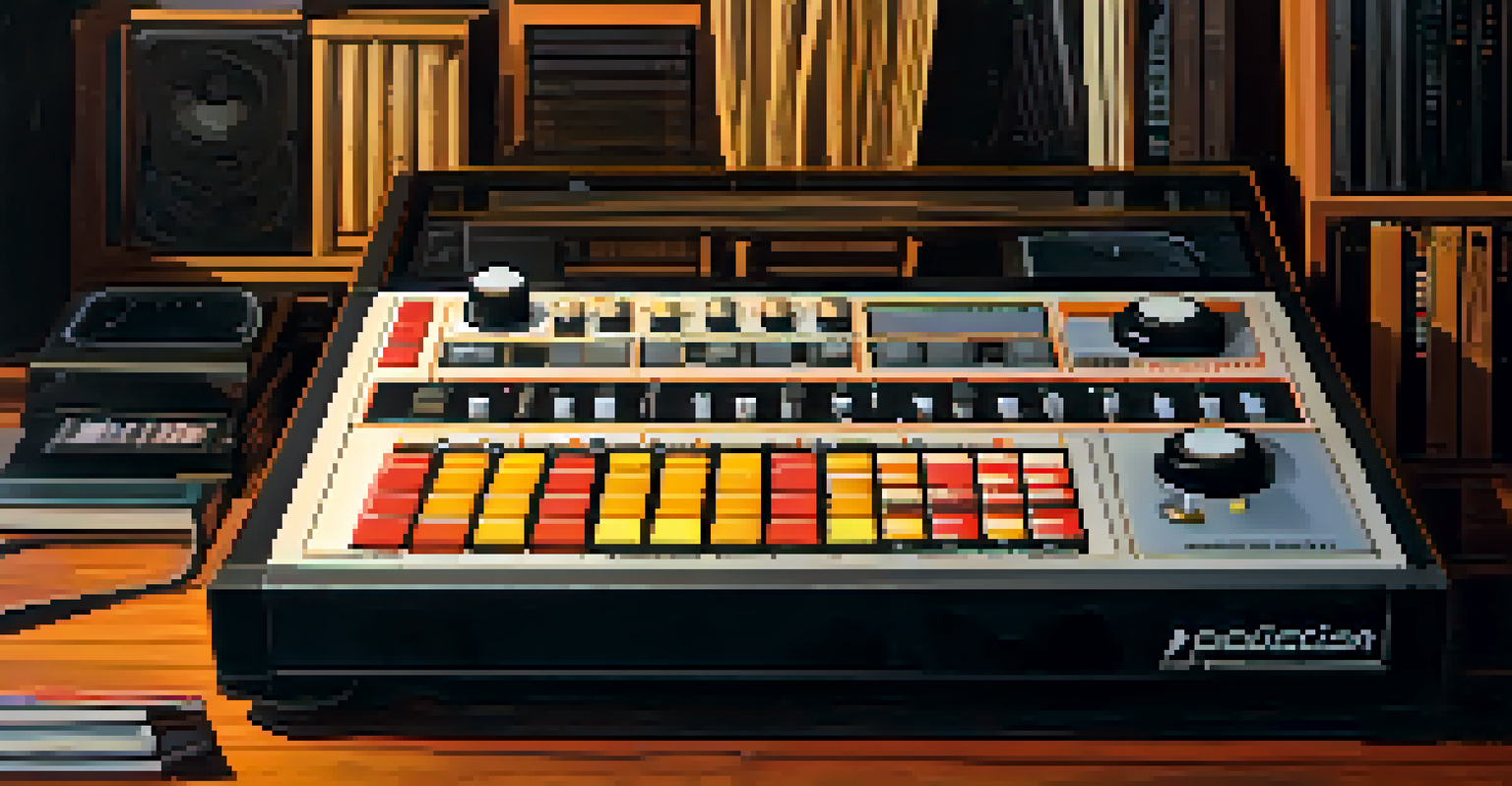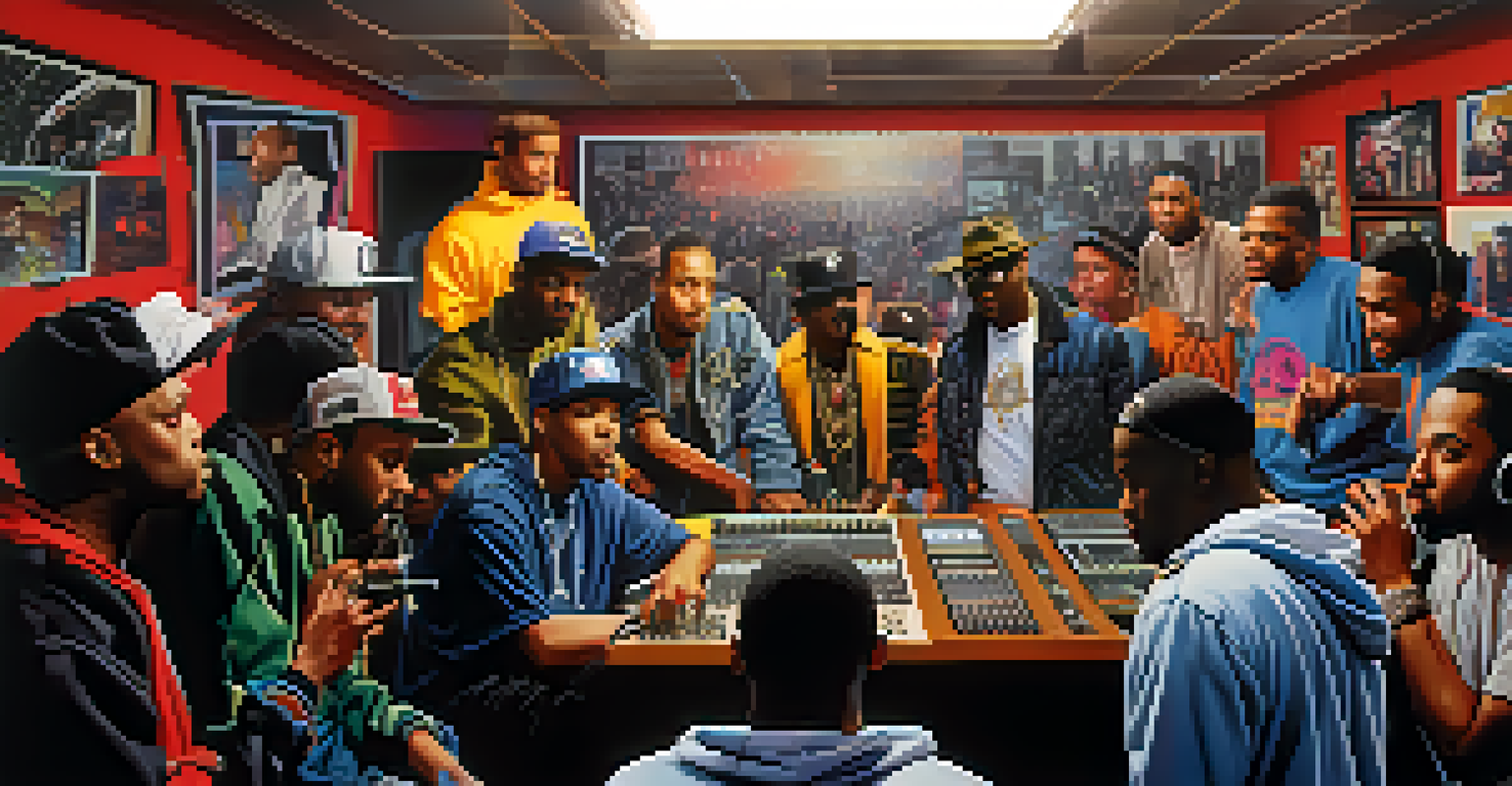The Birth of Hip-Hop: 1980s Cultural Movement in Music

The Roots of Hip-Hop: A Cultural Shift in the 1980s
The 1980s marked a pivotal moment for hip-hop, emerging as a cultural force that resonated with urban youth. It was born out of the struggles and aspirations of communities, particularly in the Bronx, New York. As neighborhoods faced economic hardships, hip-hop became an outlet for self-expression and creativity, transforming the narrative of marginalized voices.
Hip-hop is a vehicle for social change and a platform for marginalized voices to be heard.
The movement combined various elements like breakdancing, graffiti art, and DJing, each contributing to a vibrant cultural tapestry. Block parties became the backdrop for this artistic expression, where local DJs spun records, and dancers showcased their skills. This communal atmosphere fostered a sense of belonging and identity among participants.
As hip-hop gained momentum, it began to influence not just music, but fashion, language, and art. The cultural shift was palpable; traditional music genres were being challenged, and a new generation of artists emerged, eager to share their stories through this innovative medium.
Key Figures Who Shaped Hip-Hop in the 1980s
Several pioneers emerged during the 1980s, each playing a crucial role in defining hip-hop. Artists like Grandmaster Flash and Afrika Bambaataa were instrumental in popularizing DJing techniques and introducing socially conscious themes into their music. Their work laid the groundwork for future generations of hip-hop artists.

Another influential figure was Run-D.M.C., who fused hip-hop with rock elements, creating a unique sound that attracted a broader audience. Their collaboration with Aerosmith on 'Walk This Way' is often cited as a turning point that brought hip-hop into the mainstream music scene. This crossover appeal expanded the genre's reach and solidified its place in popular culture.
Hip-Hop's Rise in the 1980s
The 1980s marked a turning point for hip-hop, establishing it as a cultural movement that empowered urban youth through self-expression.
Additionally, female artists like Salt-N-Pepa broke barriers, proving that women could thrive in a male-dominated industry. Their hit songs brought attention to women's issues and empowerment, showcasing the diverse voices within hip-hop. These key figures not only shaped the sound of the era but also promoted a message of unity and resilience.
The Influence of Technology on Hip-Hop Music
The 1980s saw significant technological advancements that transformed the music landscape, particularly for hip-hop. The introduction of affordable drum machines and samplers enabled artists to experiment with sound in ways that were previously unimaginable. This accessibility democratized music production, allowing aspiring musicians to create tracks from their homes.
The beauty of hip-hop is that it’s a reflection of life, it speaks to the struggles and the triumphs of the community.
One notable innovation was the use of the Roland TR-808 drum machine, which became a staple in hip-hop production. Its distinctive sound laid the foundation for countless hits, influencing not just hip-hop but also various other genres. The ability to manipulate beats and samples opened up new creative avenues, leading to a rich diversity of sound.
As hip-hop producers began to explore these technologies, they also paved the way for the emergence of sub-genres. Artists experimented with different styles, leading to the birth of genres like gangsta rap and alternative hip-hop. This experimentation was crucial in establishing hip-hop as a dynamic and evolving art form.
The Role of Media in Propagating Hip-Hop Culture
The rise of hip-hop in the 1980s coincided with significant changes in media, particularly with the advent of music videos. Shows like 'Yo! MTV Raps' provided a platform for hip-hop artists to reach wider audiences, showcasing their music and style. This exposure was vital in shaping public perception and elevating the genre's status.
As hip-hop gained visibility, it began to influence fashion trends and youth culture. Artists became trendsetters, with their unique styles becoming synonymous with the hip-hop identity. Baggy pants, oversized shirts, and flashy jewelry became staples, reflecting the cultural ethos of the time.
Technological Impact on Music
Advancements like affordable drum machines and samplers revolutionized hip-hop production, allowing artists to innovate and diversify their sound.
Media also played a role in the storytelling aspect of hip-hop, allowing artists to share their narratives with the world. Documentaries and interviews provided insight into the lives of hip-hop artists, helping to humanize their experiences. This connection fostered a deeper appreciation for the art form and its cultural significance.
The 1980s: A Decade of Hip-Hop Innovation
Innovation was at the heart of hip-hop during the 1980s, with artists constantly pushing the boundaries of the genre. From the emergence of new styles to the experimentation with sound, each year brought fresh ideas and influences. The originality of the music reflected the diverse experiences of the artists, making hip-hop a rich tapestry of creativity.
Notably, the late 1980s witnessed the rise of politically charged lyrics, with artists like Public Enemy using their platform to address social issues. Their powerful messages resonated with listeners, sparking conversations about race, inequality, and justice. This emphasis on storytelling added depth to hip-hop, transforming it from mere entertainment into a powerful social commentary.
As hip-hop continued to evolve, it began to establish itself as a legitimate genre worthy of recognition. The Grammy Awards eventually acknowledged hip-hop, signifying its acceptance in the mainstream music industry. This validation was crucial for artists, solidifying hip-hop's legacy as not just a passing trend but a lasting cultural movement.
The Global Reach of Hip-Hop in the 1980s
While hip-hop originated in the Bronx, its influence quickly spread beyond the borders of the United States. The 1980s saw the genre making its way to countries around the globe, inspiring local artists to adopt and adapt the style. This global reach showcased hip-hop's versatility and its ability to resonate with diverse cultures.
In places like France, the hip-hop scene began to flourish, with artists incorporating their own languages and experiences into the music. Groups like Suprême NTM emerged, blending French lyrics with the hip-hop sound, creating a unique fusion that captivated audiences. This cross-cultural exchange enriched the genre, allowing it to evolve in new and exciting ways.
Global Expansion of Hip-Hop
Hip-hop's influence rapidly spread worldwide in the 1980s, inspiring local adaptations that showcased the genre's versatility across cultures.
Similarly, the UK experienced its own hip-hop renaissance, with artists exploring the genre through a distinctly British lens. The emergence of UK garage and grime in the late 1980s laid the groundwork for a thriving hip-hop scene that continues to this day. This global expansion highlighted hip-hop's universal appeal and its power to connect people across different backgrounds.
The Legacy of 1980s Hip-Hop: Setting the Stage for the Future
The impact of the 1980s hip-hop movement is still felt today, with its legacy shaping contemporary music and culture. The genre laid the groundwork for the diverse sounds and styles that define modern hip-hop, influencing everything from pop music to fashion. Artists continue to draw inspiration from the pioneers of the 1980s, ensuring that their contributions are never forgotten.
Moreover, the themes explored during this era—social justice, identity, and resilience—remain relevant in today's music. Current hip-hop artists often reference the struggles and triumphs of their predecessors, creating a dialogue between generations. This continuity fosters a sense of community within the hip-hop culture, bridging the gap between past and present.

Ultimately, the 1980s were a transformative time for hip-hop, marking its transition from an underground movement to a global phenomenon. As we celebrate the roots of hip-hop, it's essential to recognize the artists and cultural shifts that shaped it. The journey of hip-hop is ongoing, and its story continues to evolve, driven by the voices of those who dare to express themselves through this powerful medium.